
Environmental Biotechnology - Jordening and Winter
.pdf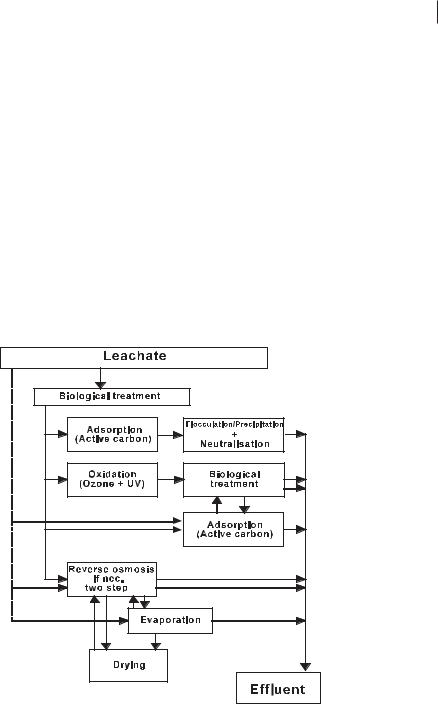

38815 Landfill Systems, Sanitary Landfilling of Solid Wastes, and Long-term Problems with Leachate
•measuring facilities for recording meteorological data such as precipitation, temperature, wind, evaporation
•measuring facilities for collecting the quantities of leachate and water that are needed for analyzing the water balance
•measuring facilities for recording the quality of leachate and other waters
In addition, if the generation of landfill gas is expected, it is necessary to provide facilities for measuring landfill gas and to install gas level indicators for the purpose of emission control.
15.4
Long-term Problems with Leachate
The characteristics of landfill leachate are relatively well known, at least for the first 20–30 years of life of the landfill, the period from which actual data are available. On the other hand, little is known about the leachate composition of later phases of the landfill, and the basis for making good estimates is rather weak.
For this reason, several landfills were investigated in a German joint research project ‘Landfill Body’ (Ehrig et al., 1997). The purpose was to describe the present stage of stability of landfills of different ages, their corresponding emissions, and the future development of emissions.
The main focus of the research program included long-term experiments in test lysimeters that were carried out to predict emissions that the solid waste in old landfills will release in the future.
15.4.1
Lysimeter Tests in Landfill Simulation Reactors (LSR)
To describe the effects of future biological and thermal pretreatment on leachate emissions, landfill simulation experiments were carried out under anaerobic conditions. The test system ensured that the typical landfill phases, such as the acid phase and the stable methane phase, took place in sequence in the reactor. Choosing appropriate milieu conditions enabled the researchers to achieve an enhanced biologic degradation process. By this means, the maximum emission potential represented by gas production and leachate load were determined within reasonable periods of time (Heyer et al., 1997; Stegmann, 1981).
The range of emissions in the water phase that can occur in the landfill in the future was based on experiments in four LSR lysimeters. Figure 15.8 shows concentrations of COD and TKN on a logarithmic scale during a test period of more than 1000 d:
•The COD concentrations showed very similar qualitative declines that followed a gradual asymptotic course, which can be described as a function of dilution and mobilization. The BOD5 concentrations were very low as expected, because almost all waste samples were in the stabilized methane phase when the tests began. The BOD5/COD ratio was lower than 0.1.
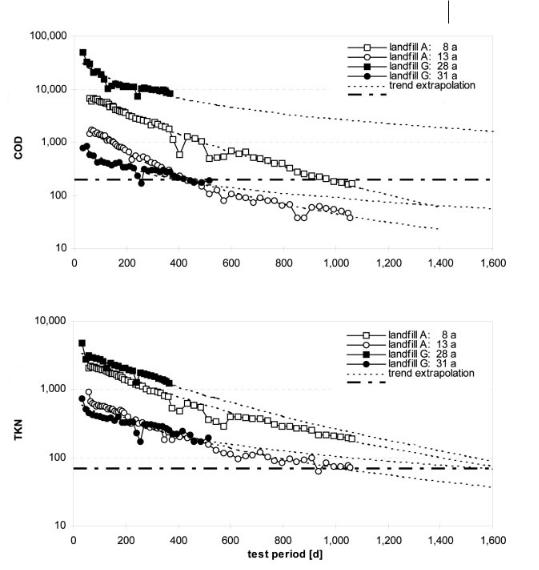

39015 Landfill Systems, Sanitary Landfilling of Solid Wastes, and Long-term Problems with Leachate
15.4.2
Prognosis of Periods of the Long-Term Time Course of Emissions
The time course of leachate emissions depends mainly on:
•the potential substances that can be mobilized
•the water balance in the landfill, mainly the water flux
•the mobilization behavior
These LSR tests did not allow final, generalizing predictions for the development of emissions development with time. One reason was the specific conditions of each landfill site, e.g., the climate, the surface cover, the waste composition, and inhibition effects. Another reason was the high water exchange rate in the LSR tests that was used to simulate accelerated conversion, mobilization. and dilution in the landfill. However, the possible future development of emissions is discussed below.
The time course of emissions can be described with an exponential function. With the idealized conditions in the LSR test devices and the setting of a water balance, which was approximately 100 times higher than at the landfill, periods TE can be estimated, until a limiting value CE is reached. The estimations are based on the following assumptions:
•constant climatic leachate generation of 250 mm per year (this means no impermeable surface sealing, only a permeable soil cover)
•a standard height of 20 m
•the dry densities in the LSR tests are similar to those in the landfill, approximately 0.75 Mg TS m–3
•uniform percolation through the landfill body
Table 15.3 Estimations of periods TE for reaching the limiting values CE (Heyer, 2003).
Parameter |
CE |
C0 |
T1/2 |
TE |
|
Limiting Value |
Concentration |
Half Life |
Periods |
|
|
at Test Start |
|
|
|
|
[mg L–1] |
[a] |
[a] |
|
|
|
|
|
COD |
CE = 200 mg O2 L–1 |
500–12 700 |
10–40 |
80–360 |
|
mean |
5100 |
28 |
140 |
|
|
|
|
|
TKN |
CE = 70 mg L–1a |
200–2100 |
15–57 |
120–450 |
|
mean |
1200 |
43 |
220 |
|
|
|
|
|
Cl |
CE = 100 mg L–1 |
340–2950 |
15–43 |
90–250 |
|
mean |
1200 |
33 |
140 |
|
|
|
|
|
AOX |
CE = 500 µg L–1 |
390–2380 µg L–1 |
14–42 |
30–210 |
|
mean |
1600 µg L–1 |
22 |
80 |
a Total amount of nitrogen = sum of ammonia, nitrite, and nitrate.
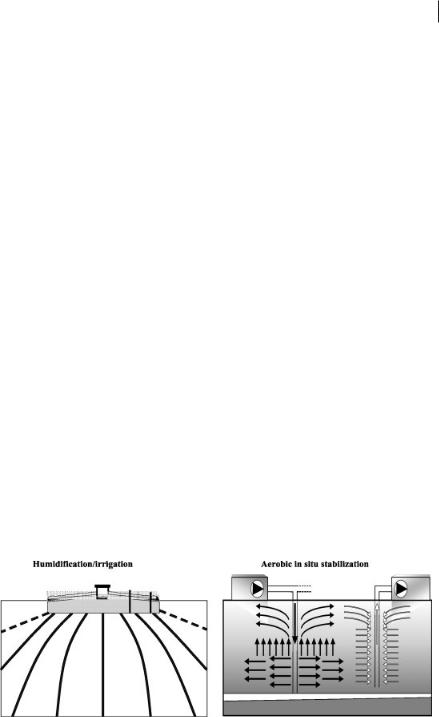

39215 Landfill Systems, Sanitary Landfilling of Solid Wastes, and Long-term Problems with Leachate
15.5.2
Technical Methods for Water Infiltration and Effects on Leachate
Technical methods for water infiltration must be planned so that controlled, even moisture penetration of the landfill body is guaranteed. Likewise, short circuit currents and preferred seepage paths must be avoided by using suitable measures.
Various technical methods are available for use with regard to water infiltration into the landfill body. At the same time, the effect of the infiltration plants on existing surface sealing systems or on systems that are yet to be installed is of great importance. The choice of infiltration system is additionally determined by the quality of the infiltration medium (see above) and the quantity to be infiltrated.
Depending on the landfill boundary conditions and the targets of infiltration, the following infiltration methods may be used:
•horizontal infiltration systems below the surface sealing system
–two-dimensional infiltration methods
–linear infiltration methods
•vertical infiltration systems
–use of existing vertical gas collectors
–vertical deep wells
–infiltration injectors in short screen distances
Combinations of the individual infiltration systems can be used. The experience gained so far with regard to controlled infiltration can be summarized as follows:
•positive experiences
–enhancement of gas production: up to three times higher
–longer economic life of the gas
–accelerated stabilization of the waste body and reduced leachate contamination
•negative experiences
–blockage and incrustation in the infiltration system
–shearing, rupture, and buckling of pipes
–uneven water introduction or no water introduction in subareas
15.5.3
Aerobic In Situ Stabilization and Effects on Leachate Contamination
Aeration processes for aerobic in situ stabilization are being used in several German landfills and old deposits with success. Common to all sites is the ultimate target: the controlled reduction of emissions and of the resultant risk potential of leachate within a relatively short period of time with the goal of economical site closure, aftercare, and securing measures (Heyer et al., 2003).
The basic technical concept of aeration consists of a system of gas wells, through which atmospheric oxygen is fed into the landfill body via active aeration in such a way that aerobic stabilization of deposited waste is accelerated. Simultaneously, the low-contaminated waste gas is collected and treated in a controlled manner by means of other gas wells.
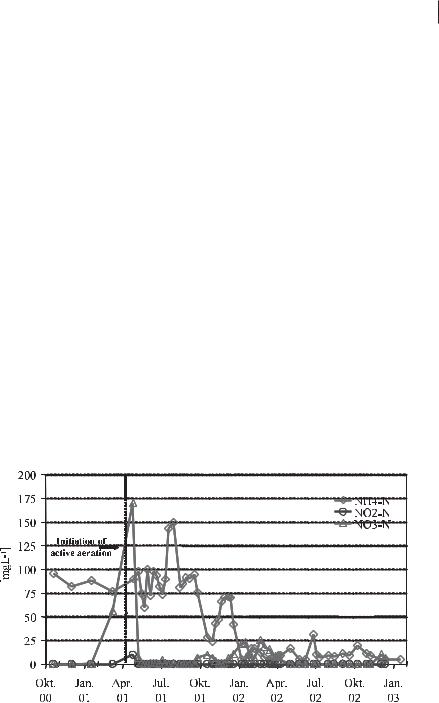
15.5 Controlled Reduction of Leachate Emissions 393
In principle, the following processes occur during aeration in the landfill body:
•A change from anaerobic to aerobic conditions takes place, resulting in an accelerated and, in part, broader degradation of the bioavailable waste components. The increased carbon conversion during in situ aeration therefore leads to faster stabilization of organic substances.
•At the end of the stabilization process, organic compounds consist of only nearly or completely nondegradable compounds with very low residual gas potential.
•In the leachate path, accelerated decrease in the parameters COD and, above all, BOD5, as well as in nitrogen (TKN or NH4-N) occurs with the aerobic degradation of organic compounds and their release into the gas phase (mainly as carbon dioxide) as a result of aeration.
•Compared with strictly anaerobic conditions, the aftercare periods for the leachate emission path are reduced by at least several decades by in situ aeration. The aftercare phase is not considered complete after aeration has been terminated, but aftercare expenses are significantly reduced, since costly leachate purification measures can be terminated earlier. If leachate percolates directly into the underground, as sometimes occurs in old deposits lacking sealing and drainage systems for the collection of leachate, the polluting effects would be considerably lower.
In situ aeration is planned to operate for a period of 2–4 years under average landfill conditions. Meanwhile, results and experience concerning the operation of stabilization measures are available for several sites for a period of 2–3 years (Heyer et al., 2003). Figure 15.10 shows, as an example, the development of nitrogen contamination in the leachate and groundwater off-flow from an old landfill. From the outset of aeration in April 2001, a considerable decrease in the nitrogen contamination can be seen after one year of stabilization, in spite of several deviations.
Fig. 15.10 Changes in leachate contamination within the off-flow area during aerobic in situ stabilization of the old Kuhstedt waste deposit (Heyer et al., 2003).

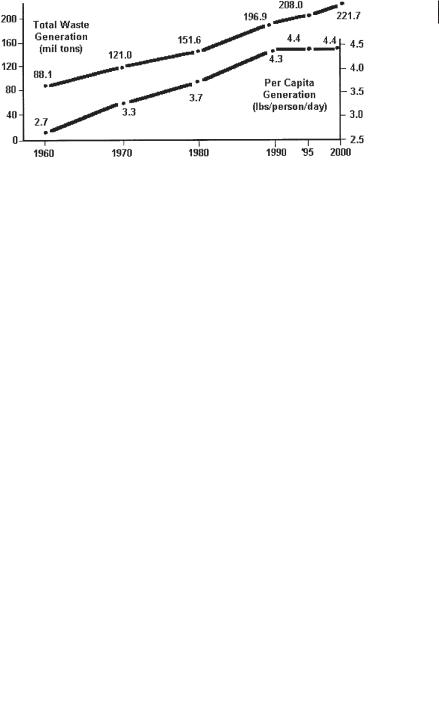
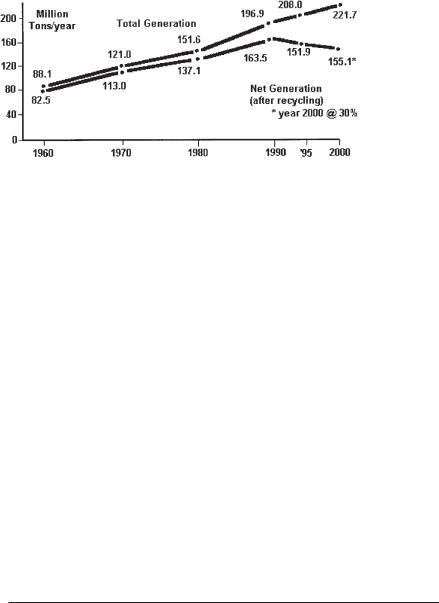
396 16 Sanitary Landfills: Long-term Stability and Environmental Implications
Fig. 16.2 Total and net waste generation, 1960–2000 (U.S. EPA, 1997a).
Because of recycling efforts, the net generation rate has been decreasing (Fig. 16.2). Net generation is the amount of solid waste remaining from the total amount generated after materials such as newspaper, glass, and aluminum have been recovered by recycling activities.
Municipal solid waste is a heterogeneous mixture of the materials that society uses. General categories include food wastes, paper, cardboard, plastics, textiles, rubber, leather, yard wastes, wood, glass, ‘tin’ cans, and ferrous metals.
The standard unit for reporting waste generation is mass. However, mass data are of limited value for certain applications such as landfill design, since average landfill requirements depend on the volume of waste. In addition to the original density of any materials making up the solid waste mixture, the volume also depends on how much the waste has been compacted (Table 16.1).
The comparative percentages of various components of the waste stream are variable. Composition varies geographically and is also influenced by efforts in source reduction and recycling (Table 16.2).
In summary, large amounts of municipal solid waste are generated, and the waste is diverse in nature. These wastes must be managed for the control of disease vectors and for protection of the environment.
Table 16.1 Density of municipal solid waste as influenced by compaction (according to Tchobanoglous et al., 1991).
Component |
Density (kg m–3) |
|
|
Residential |
130 |
In compactor truck |
300 |
In landfill (normal) |
450 |
In landfill (well compacted) |
590 |
Baled |
700 |
|
|
